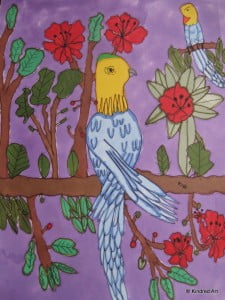 Why did you stop drawing?
Why did you stop drawing?
Why do children stop drawing and what happens to adults who used to draw but now profess they can’t draw?
One of the most common things I hear adults admit to me with regards to art is that they can’t draw or that they only can draw stick people!
So what happened? What happens that stop us from having the freedom to draw.
Children develop in stages. Starting at the first stage of Self Expression (scribbling) then going through other stages to end up with the desire to see the world around them for what it is and to draw realistically.
I recommend viewing this chart of the Drawing developmental stages in children by Victor Lowenfeld author of Creative and Mental Growth and Betty Edwards author of Drawing on the right side of the Brain.
It is very interesting to note why they children stop drawing.
- The scribbling stage – 1 and 1/2 years
- The Stage of Symbols – 3-4 years
- Pictures that tell stories – 4-5 years
- The Landscape – 4 or 5 years
- The stage of complexity – 9 or 10 years
- The stage of realism
- The crisis period The beginning of adolescence
When do children STOP drawing – The crisis of realism
By the age of 8-9 schematic drawings become more realistic, and many children exhibit greater visual awareness of the things around them. They want to create the a drawing that looks “real” As a result, they become increasingly conscious of details and proportion in what they are drawing.
The need to make the picture look “right” leads to a crisis for many older children. In trying to draw realistic, children often get disappointed of their own drawings. They are becoming more critical in their graphic depictions and gradually Stop or decline engaging in Drawing activity.
Some children will naturally learn how to “see” artistically, some will develop their own style and continue to draw and be artistically talented their whole lives. There are many children draw this way!
Expectation
In her book Drawing with Children Mona Brookes sums it up very nicely.
[quote]”We don’t expect children to play the piano, study dance, or learn a sport without showing them the basic components of these subjects. Why do we expect them to understand the complexities of drawing on their own?
Imagine expecting children to write creative stories without teaching them the alphabet and the structure of Language. Learning the language of drawing and painting is likewise essential for anyone wanting to pursue those arts creatively.
Adults who think they can’t draw are taught by methods that include demonstration, visual exercise techniques such as mirror imaging, copying other line drawings upside down, and drawing the edges of negative space.
Children need to learn the drawing process also, but with similar exercises that are geared to their age level. Children’s creativity is not stifled if they’re provided with a very general structure and are allowed to interpret the information any way they wish. “[/quote]
[pullquote_right] Remember: EVERYONE can draw. Drawing, like writing and reading, is a skill and not just a gift given to a few. [/pullquote_right]
Art is one of those things that given proper instruction anyone can start. It doesn’t matter you age. Young Children through Adults can start learning these same principles and go on to do lovely realistic renderings.
Confidence and Creativity
Art brings an immense amount of confidence and creativity to a person to which they can use in many aspects of their lives.
When we look around us we find that art is everywhere and that is why inside most people want to be apart of that beauty. Drawing plays a fundamental role in artistic creation. Many artistic endeavors rely on a mind that has learned how to see and and a person who has the confidence to believe they can see.
Remember
Above all remember, there is no wrong or right way to draw. It is all about making it look “right” to you.